Science of Waterfowling
Four DU biologists, who are also hard-core waterfowlers, share their proven tactics for a successful day in the marsh
Four DU biologists, who are also hard-core waterfowlers, share their proven tactics for a successful day in the marsh

All work and no play is not an issue with these DU scientists. Duck statistics, duck habitat analyses, and duck population models are just some of their passions. Like the rest of us, they also dream of ducks over the decoys, wings locked and feet down. These folks are at the top of the conservation game, fighting for habitat and pursuing a clearer understanding of what makes waterfowl populations tick. But don't think they prefer a laboratory over a duck blind. They're just as stoked as the rest of us when opening day rolls around.
They know that it takes hard work to chase a duck. But they know that working smart is important too. Listen up, because they're about to tell you how they combine their knowledge of waterfowl biology with their years of hunting experience to bring more birds to the bag.
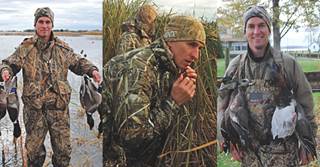
Photo Mike Brasher
Brasher grew up in north-central Mississippi, hunting the scrub-shrub backwater sloughs of the Skuna River Valley. "Growing up in the South, where the birds are really skittish, was a huge influence," he says. "I'm very methodical about finding where the birds want to beand very careful to avoid spooking them while I'm looking."
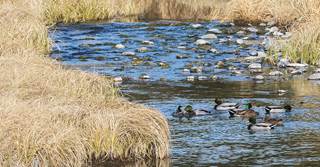
Avoid spooking ducks while scouting and you're more likely to have success when you return with a shotgun in hand.
Photo Ken Archer
Brasher scouts hardand not just for ducks. "I scout for food sources just like a deer hunter would," he says. "Nature produces a lot of groceries, and it's easy to identify most of the foods that will attract and keep ducks in one spot." Brasher drives around and looks for moist-soil areas flush with annual grasses and sedges such as panic grass, signal grass, and foxtail. You don't have to have a botany degree to recognize the good stuff, he says. "When you walk through a grassy field in late summer or early fall and look down to see seeds all over your boots, chances are that's duck food." These seeds differ in their nutritional value, but Brasher cautions not to get caught up in the details. "Just look for an abundance of natural seeds and make a note to return during duck season."
Brasher also scouts smart. He is keenly cautious about bumping birds off water where they feel comfortable. "In the past few decades, hunters have gotten very good at accessing every square inch of where a duck wants to be," he says. ATVs, mud motors, and small boats keep ducks in an almost constant state of motion during hunting season. But none of that changes the basics. "Find the food and be where the ducks want to be. Try not to disturb them. And when it's time to hunt, wear a face mask and gloves and stay still. Those things will hold true till the end of time."
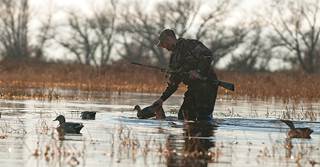
Photo sharpeyeimages.com
Brasher's graduate work involved studying breeding mallards in Manitoba and Saskatchewan, so he's very much attuned to behavioral cues in paired ducks. "By late December and early January, most mallards, pintails, gadwalls, and black ducks are paired up," he says. "I emulate that social status with my decoys." Brasher places several duck pairs or a small grouping of two drakes and a hen off to the side of the spread. "Paired ducks sort of hang out on their own. They've made their choice, and now they just want to get fat and happy. Pairing decoys takes advantage of that natural tendency."
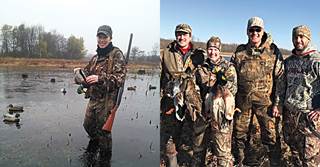
Photo Sarah Fleming
Fleming lives outside Syracuse, New York, about 20 minutes from the famed Montezuma Wetlands Complex, which includes more than 50,000 acres of protected lands in federal, state, and private ownership. She and her husband, Michael Schummer, who is also a waterfowl biologist, focus 99 percent of their hunting effort on public lands, often hunting the enormous expanses of cattails that fringe Lake Ontario and state wildlife management areas just to the south. Their success in the big cattails could be duplicated in similar habitats elsewhere.
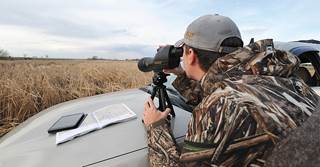
Photo Jim Thompson
"It's a little like timber hunting," Fleming says. The cattail stands are often as tall as 10 feet, pocked with openings from a half-acre to perhaps five acres. Those openings can boast a flush of duck foods such as submersed aquatic vegetation and protein-rich invertebratesbut getting there is a slog. They pack a two-person kayak with a couple dozen mallard and black duck decoys and one of their two retrievers, and then they paddle, drag, and sweat their way to open water. Hiding is as simple as stepping back into the wall of cattails, but attracting ducks is more complicated. They'll raise a couple of spinning-wing decoys above the cattails by duct-taping the decoy pole to the top of a 12-foot wooden spar and jamming it into the mud. "It's critical to get that decoy above the cattails," Fleming explains, "so it's worth taking some effort to accomplish that." And they kick the water to create ripples and movement to attract birds. "Like I said," she laughs, "think of timber hunting in 10-foot-tall cattails."
Much of hunting these honey holes in the cattails is figuring out the sweet spots for ducks. Poring over Google Earth can help to locate openings in the dense vegetation. But a lot of the effort involves scouting just prior to the hunt by glassing lake shorelines to figure out where the ducks want to be. "Nothing comes easy. We have to figure it out just like everybody else," Fleming says, "which means leaving the house at 2:30 in the morning to beat the crowds."

When hunting in areas with tall vegetation, try mounting your spinner on extra-tall poles so passing ducks will be able to see them.
Photo Sarah Fleming, DU
Fleming and her husband both work as waterfowl biologists. "You can imagine our dinner conversation," Fleming says. "We do love data." They are totally wired to waterfowl ecology, but that's not so different from many hard-core duck hunters. While monitoring bird movements through DU's migration alerts and other online bird migration applications, she also keeps tabs on how much water is on the landscape. Flow gauges in natural water bodies and man-made canals are readily available online and reveal real-time data on water levels. Keeping good notes over time helps her correlate water readings with where and how water is moving across known hunting locations. "Some hunters get fixated on going back to the same spot and hoping the birds will show up," she says. "But it's much more effective to do your research and be willing to move."
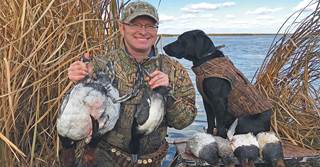
Photo Scott Stephens
An Iowa native, Stephens logged his master's research on wood ducks in Southern swamps and has current responsibilities across Canada. He knows ducks. And he knows you have to find where they want to be.
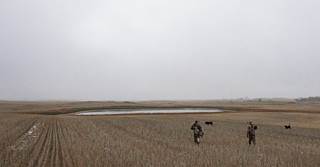
Stephens likes to hunt these small, shallow ponds where ducks gather to rest before or after feeding in surrounding grain fields.
Photo jeffmooreimages.net
It's no surprise that Stephens puts a premium on scouting in prairie potholes. "It's common to drive a couple hundred miles a day to find where the birds really want to be," he says. And while Stephens loves a monster field shoot as much as anyone, he has a particular passion for hunting day-roost pondssmall, shallow waters frequented by ducks as they fly to or from fields. "These are not roosting ponds," Stephens explains. "The birds are stopping there after filling up with waste grain in the morning, or they are on their way to the fields in the late afternoon. That's why they're also called sipping ponds,' and the shooting there can be spectacular."
Finding them requires keeping your eyes open for a different flight behavior while scouting. "You'll see birds working around, and then they just disappear," he says. "No circling. The birds simply vanish. That's when you sneak in and look for these small, shallow ponds, some of which might not be 30 yards wide. But they can be just slam full of ducks, because the birds get very comfortable there."
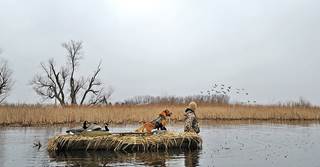
Photo Jim Thompson
Like any other type of prairie hunt, you'll need to find cover to hunt a sipping pond. Stephens places a mix of floaters and full-body decoys in the shallow waters to emulate the way birds use these habitats. And he leaves little to chance. "These spots can get messed up if someone hunts the field the birds are feeding in," he says. "Make sure no one hunts it prior to you staking out the sipping pond. That activity will move the birds off and change their paths."
And don't be dismayed if you arrive at the pond and don't raise a feather. "A lot of times I'll take people out to a sipping pond and we walk in before light and they say, Uh-oh. There aren't any birds here,'" Stephens laughs, "and I'll say, Yep, that's perfect! Just you wait!'"

Understanding what different species are doing throughout the migration and wintering periods can help you fine-tune your hunting tactics.
Photo michaelfurtman.com
Given his location in southern Manitoba, Stephens sees waterfowl responding to various environ-mental conditions and physiological needs throughout the season.
"Different birds have different needs, even at the same time of the year," he explains. Consider blue-winged teal. Early in the season, they are massing in Manitoba with a serious focus on feeding in shallow wetlands. "But at the same time, mallards have another month or more before they might head south. The teal are really focused on those waste grains, but the mallards are hanging out more in the water. They don't yet feel the need to pack on the fat." Understanding what different bird species need at various times in the migration enables Stephens to target his efforts and not waste timeor precious sleephunting where the birds aren't.

Photo Mark Petrie
Petrie hunts a big swath of the Pacific Northwest, from the coastal lowlands of Washington and Oregon to the sprawling agricultural valleys in the inland regions. But he loves hunting coastal estuaries. He has plenty of practice: Petrie grew up hunting eiders in New Brunswick, where 35-foot tides aren't uncommon.
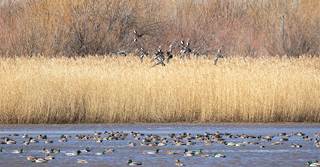
Photo Scott Fink
Among his favorite haunts is Willapa Bay, the second-largest estuary on the US Pacific Coast. While he travels with pals to hunt elsewhere, he's typically solo on a Willapa Bay hunt, and he's learned to turn that into an advantage.
Petrie watches for two conditions to converge before he packs his shotgunan incoming tide in the morning and a brisk but not dangerous wind. "A tide that's rising all morning is perfect," he explains. "I'm typically hunting big mud flats with sparse vegetation, and a rising tide gives me the longest hunting window. And a 20-mile-per-hour wind helps push birds off big water and bring them in to feed. It's a strategy anyone could use in a low coastal environment." Petrie paddles a Marsh Rat one-man hunting boat and sets out a couple dozen mallards, green-winged teal, and pintail decoys. "You jam that boat into the marsh and you're all set until the tides force you to move your decoys."
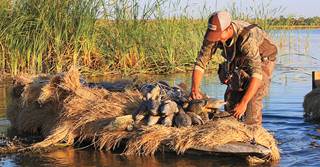
One-man layout boats are perfect for hunting the Northwest's coastal marshes.
Photo dougsteinke.com
In fact, taking advantage of changing conditions seems to be a hallmark of Petrie's hunting life these days. His kids are in their early 20s, so he's finding more free time than in the past, and he's putting it to good use. Petrie recently started carving decoys and just picked up an RNT Daisy Cutter call, a departure from his standard call choice. "I blew a double-reed call for years," he says, "so I've been putting in quite a bit of time to go from a double-reed to a single-reed call. I like its crisp, clean sound. Now we'll have to see what the ducks think about it."

Petrie has pored over food depletion studies throughout his career, so he's keenly aware of how quickly saline coastal marshes run out of duck food. Luckily, that often coincides with the rainy season in the inland agricultural valleys. "The hunters who are really successful here have multiple hunting options and are able to respond to bird movements," he explains. "If you really want to take advantage of the 107-day season we're blessed with, you have to be prepared to move. Just like the ducks."
Ducks Unlimited uses cookies to enhance your browsing experience, optimize site functionality, analyze traffic, and deliver personalized advertising through third parties. By continuing to use this site, you agree to our use of cookies. View Privacy Policy